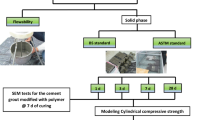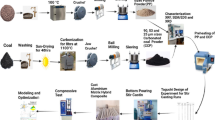Abstract
In present work, the compression strength and tensile strength of phosphate graphite sand with compositional and technological parameters (phosphoric acid, Al2O3, drying temperature, and drying time) were experimentally investigated. An L9 (34) orthogonal array was employed to analyze the effect of these four parameters on the compression strength and tensile strength, respectively. In addition, the radial basis function artificial neural network (RBFANN) was used to establish the models for compression strength and tensile strength, respectively. Moreover, the simulation and prediction results by the RBFANN and linear and non-linear regressions are compared. The results are as follows: the optimum scheme for phosphate graphite sand designed by us is phosphoric acid 24%, Al2O3 30%, drying temperature 400 °C, and drying time 60 min. The ascending sequence of the effect of four factors on both compression strength and tensile strength of phosphate graphite sand is drying time, drying temperature, Al2O3, and phosphoric acid. In addition, the prediction and simulation results show that RBFANN outperforms Taguchi approach for modeling.





Similar content being viewed by others
References
W. Bo-kang, C. Qi-zhou, L. Han-tong, The Characteristics of Cryp to-crystaline Graphite Sand and its Application in Al-alloy Castings, Foundry (in Chinese) 1997, 47(7), 1–5
S. Gui-qiao, X. Hua-sheng, Z. Chun-hui, Study on Infrared Preheating Process of Graphic Mould for Thin-walled Titanium-alloy Casting, Foundry (in Chinese) 2004, 53(3), 194–196
P. Ye, Z. Chuan, Z. Yan-cheng, S. Guo-xiong, Fabrication of Al2O3 Ceramic Matrix Composites and their Microstructure, Special Casting Nonferrous Alloys (in Chinese) 2005, 25(6), 347–349
J. Paulo Davim, Design of Optimisation of Cutting parameters for Turning Metal Matrix Composites Based on the Orthogonal Arrays, J. Mater. Process. Technol. 2003, 132, 340–344
J. Paulo Davim, An Experimental Study of the Tribological Behavior of the Brass/Steel Pair, J. Mater. Process. Technol. 2000, 100, 273–277
E. Bagci, S. Aykut, A Study of Taguchi Optimization Method for Identifying Optimum Surface Roughness in CNC Face Milling of Cobalt-based Alloy (Stellite 6), Int. J. Adv. Manuf. Technol. 2006, 29, 940–947
Y.-z. Fan, Y.-y. Wang, P.-Y. Qian, J.-D. Gu, Optimization of Phthalic Acid Batch Biodegradation and the Use of Modified Richards Model for Modelling Degradation, Int. Biodeterior. Biodegrad. 2004, 53, 57–63
C.C. Tsao, Taguchi Analysis of Drilling Quality Associated with Core Drill in Drilling of Composite Material, Int. J. Adv. Manuf. Technol. 2007, 32, 877–884
J.-R. Shie, Optimization of Dry Machining Parameters for High-Purity Graphite in End-Milling Process by Artificial Neural Networks: A Case Study, Mater. Manuf. Processes 2006, 21, 838–845
J. Sheikh-Ahmand, J. Twomey, ANN Constitutive Model for High Strain-rate Deformation of Al 7075-T6, J. Mater. Process. Technol. 2007, 186, 339–345
A. Dharia, H. Adeli, Neural Network Model for Rapid Forecasting of Freeway Link Travel Time, Eng. Appl. Artif. Intell. 2003, 16, 607–613
L. Aijun, L. Hejun, L. Kezhi, G. Zhengbing, Applications of Neural Networks and Genetic Algorithms to CVI Processes in Carbon/Carbon Composites, Acta Mater. 2004, 52, 299–305
G. Serpen, Y.F. Xu, Simultaneous Recurrent Neural Network Trained with Non-recurrent Backpropagation Algorithm for Static Optimization, Neural Comput. Appl., 2003, 12, 1–9
K.G. Keong, W. Sha, S. Malinov, Artificial Neural Network Modelling of Crystallization Temperatures of the Ni–P Based Amorphous Alloys, Mater. Sci. Eng. A, 2004, 365, 212–218
M. Sen, H.S. Shan, Optimal Selection of Machining Conditions in the Electrojet Drilling Process Using Hybrid NN-DF-GA Approach, Mater. Manuf. Processes 2006, 21, 349–356
H. Saxén, F. Pettersson, K. Gunturu, Evolving Nonlinear Time-Series Models of the Hot Metal Silicon Content in the Blast Furnace, Mater. Manuf. Processes 2007, 22, 577–584
Acknowledgments
The project is supported by Science Research Fund of Hunan Provincial Education Department (06B038, 05A055), National Science Foundation of China (50774034), Science Research Fund of Hunan Provincial (06JJ20005), and Instructional Research and Reform Fund of Hunan Institute of Science and Technology (2007B06).
Author information
Authors and Affiliations
Corresponding author
Rights and permissions
About this article
Cite this article
Cai, Ah., Chen, H., Tan, Jy. et al. Optimization of Compositional and Technological Parameters for Phosphate Graphite Sand. J. of Materi Eng and Perform 17, 465–471 (2008). https://doi.org/10.1007/s11665-007-9188-y
Received:
Revised:
Accepted:
Published:
Issue Date:
DOI: https://doi.org/10.1007/s11665-007-9188-y




